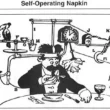One of the most challenging aspects of attempting to unravel the financial crime described in this podcast series and in the pages of deepcapture.com is separating the corrupt players from those who’ve merely been influenced by them. This is particularly true when analyzing media coverage of companies under attack by illegal, manipulative short sellers.
For the purposes of this conversation, I’m defining such companies as those included on each exchange’s Regulation SHO Threshold Securities list, which is comprised of public companies whose stock experiences an unusually high rate of ongoing delivery failures…the most reliable indicator that a stock is being strategically, and illegally, naked shorted.
I’ll be the first to point out that anybody who disagrees with my thesis can very effectively render everything that follows moot by simply disproving the implied truth contained in what I’ve just claimed: that business reporting on Reg SHO listed companies is more likely to be negative than reporting on companies not on the list. I’ll admit that I’ve not conducted a formal study to demonstrate this. Nor have I done a formal study to prove the existence of gravity. In both cases, it’s just a bit too obvious and pervasive to worry about.
So obvious and pervasive, in fact, that many observers and proponents of capital market reform arrive at the understandable conclusion that a great number of business writers are willing participants in the fraud.
Why else would they parrot the hedge fund line?
Well I’ve spent a bit of time considering this issue, and based on observation and reflections upon my personal experiences as a journalist, I’ve come to the conclusion that among business writers, actual corruption is rather rare. What is all too abundant is laziness, over-reliance on single sources, a disheartening lack of skepticism, and a tendency to regard mega-hedge fund managers as business rockstars.
Such a culture, when combined with just a bit of true corruption, yields a journalistic environment that is overwhelmingly sympathetic to the largest hedge funds, and by extension, hostile to the companies whose stock those hedge funds are shorting – often illegally.
Perhaps the best way to see this conclusion in action is to consider the following case study.
As I’ve pointed out again and again, Yolanda Holtzee – whom, I can prove, has worked for hedge funds Third Point Capital as well as Copper River Partners (nee Rocker Partners) – has been quoted in an unusual number of print business stories based on her credentials as the manager of a Seattle-based hedge fund called ALCAP.
Here’s an example, from a July, 2004 Milwaukee Journal-Sentinel story. It quotes:
Yolanda Holtzee, co-manager of the ALCAP hedge fund, based in Seattle.
A few months later, in September of 2004, Holtzee is quoted in the South Florida Business Journal:
… said Holtzee, a partner in hedge fund management firm Alcap.
Or a June, 2006 Newsday story, in which Holtzee is referred to as
…corporate gadfly and co-manager of the Seattle-based ALCAP hedge fund
Or the November, 2007 New York Post story, by Roddy Boyd, which calls Holtzee a “hedge fund manager.”
Though it’s unclear why, sometimes either the reporter or Holtzee herself will hedge, you might say, and opt against the title of “hedge fund manager,” preferring something lower key, such as “money manager” or “investment club manager”.
The best example of this is an April, 2006 profile on Holtzee appearing on the front page of the Wall Street Journal, no less. It reads…
In 1998, hoping to make more cash, [Holtzee] began managing money, she says, for a handful of wealthy individuals.
She says she stopped taking in new investors in 2000 and won’t disclose her firm’s assets under management or its performance. Holtzee refers to her company, Alcap, as an "investment club" and says she employs two traders in Connecticut and a compliance officer.
The most recent instance appears to be a May, 2008 Bloomberg News story in which reporter Yuriy Humber refers to Yolanda Holtzee as “manager of the Seattle-based ALCAP LLP fund.” This is the third such reference to Holtzee Humber has made in less than one year (1, 2, 3).
It may surprise you to learn that every one of these stories contains one key factual error: Alcap, Holtzee’s much vaunted hedge fund, does not exist.
This took me approximately 20 minutes to discover.
Another 20 minutes to verify.
Hoping to understand how such an enormous, collective, journalistic ball-dropping was possible, I conducted an experiment.
I found the two dozen most recent stories citing Holtzee as manager of ALCAP and emailed the writer of each, asking how they came to contact Holtzee initially and what they found when verifying the existence of ALCAP.
About half the reporters didn’t respond. We’ll come back to those in a moment.
Of the half that did respond, none wished to be interviewed on the record, though each told a remarkably similar story: it was Holtzee who contacted them, time and time again, usually based on the reporters’ coverage of a particular company or market sector. From that day forward, they recalled being continually pinged with information from Holtzee, some of which they found relevant and incorporated into their reporting.
At times, some admitted, Holtzee’s information provided the genesis of their stories.
On other occasions, the reporters said that, in the absence of empirical data, Holtzee would offer herself as a quotable expert, based on her status as a hedge fund manager.
On the subject of Holtzee’s credentials, all of the respondents confessed to not having verified ALCAP’s existence. Also in each case, in their defense, the reporters pointed to the 2006 Wall Street Journal story, and the belief that if the Journal said it was so, it was good enough for them.
Let’s take a look at that Wall Street Journal story.
It was written by Susanne Craig, the writer who recently authored the profile on Erin Callan, shortly before Callan was let go as CFO of Lehman Brothers.
The fawning tone of the Journal’s profile of Holtzee is best encapsulated in the following two hard-hitting sentences:
Holtzee, a self-styled Internet investigator in sweat pants, focuses on exposing out-of-bounds behavior and catching bad guys. And after pointing regulators in the right direction more than once, Holtzee has achieved two things every gadfly craves: attention from those she targets — and action.
Because this Wall Street Journal story has proven key to Holtzee’s ongoing charade, and because Susanne Craig was among the reporters who ignored by my email, I called her.
Normally, I would not publish an interview without an interviewee’s consent, but, as I’ll explain in a moment, Ms. Craig didn’t play it straight with me, so I’ve suspended the rules a bit here.
Here’s our conversation…
(transcription to come)
I’d like to make two observations.
First, when she wrote the story back in 2006, Sue Craig clearly suspected that Alcap didn’t exist. A careful re-reading of her wording then and now reveals this. Yet she chose to write about it anyway, and compounds the offense by refusing to correct the original error.
Second, Sue Craig, while too busy to contact me, had taken the time to contact Yolanda.
Based on those two observations, I conclude that the approval of whoever she was doing a favor by writing that story (and I suspect it was someone at Rocker Partners) apparently means more to Sue Craig than does her ethical duty as a journalist.
Having said that, I want to make it clear that I’m by no means accusing Sue Craig of being corrupt. I am guessing that she’s among the many A-list members of the New York financial press who relies heavily on a few sources, including mega-hedge fund managers , and whose judgment is probably compromised by a desire to maintain that relationship.
Now, what does this specific situation tell us about the larger problem of negative business coverage of companies listed on the Reg SHO Threshold Securities list?
Primarily, this is additional confirmation that a systematic media outreach effort is a key component of short-biased hedge funds’ strategies for lowering the price of targeted stocks. I say additional confirmation because it follows Jim Cramer’s earlier admission that the business press must be used for spreading rumors – by which he meant “lies” – calculated to lower target companies’ share prices.
Jim Cramer: Again, when your company’s in a survival mode it’s really important to defeat Research in Motion. You get the Pisanis of the world and the people talking about it as if there’s something wrong with RIMM. Then you would call the Journal and you get the bozo reporter on Research in Motion, and you would feed that Palm’s got a killer it’s gonna give away.
These are all the things you must do on a day like today. And if you’re not doing it, maybe you shouldn’t be in the game.
Jim Cramer: Yeah. Apple’s very important to spread the rumor that both Verizon and ATT have decided they don’t like the phone. It’s a very easy one to do because it’s also you want to spread the rumor that’s it not gonna be ready for MAC World. This is very easy ‘cause the people who write about Apple want that story, and you can claim that it’s credible because you spoke to someone at Apple, ‘cause Apple doesn’t –
Aaron Task: They’re not gonna comment. They’re not gonna –
Jim Cramer: So it’s really an ideal short. Again, if I were a short Apple, I would be working very hard today to get that. The way you would do that is you pick up the phone and you call six trading desks and say, “Listen, I just got off the phone with my contact at Verizon and he has already said, ‘Listen, we’re a Lucky G house. We’re a Samsung house. We’re a Motorola house. There’s no room for Apple. They want too much. We’re not gonna let them in. We’re not gonna let them do what they did to music.’” I think that’s a very effective way to keep a stock down.
By the way, ‘cause the stock at 84/85 – a little bit a capital you go buy some January 80 puts that makes it look like there’s gonna be something going on. So maybe give Morgan an order to buy 1,000 Jan 80 puts, and then you go position limit with …maybe you use a hack firm that doesn’t know what the heck its doing – maybe you go to UBS for puts.
You just kinda create an image that there’s gonna be news next week, and that’s gonna frighten everybody –
Jim Cramer: They all go out and say, “March put buyer: UBS.” Then they call Pisani again. You have to use those guys and say, “Listen, I see a big buyer puts and I’m told that it’s SAC.” You would do that, too. These are all what’s really going on under the market that you don’t see.
Aaron Task: Right. Nobody else talks about it.
Jim Cramer: But what’s important when you’re in that hedge fund mode is to not do a thing remotely truthful, because the truth is so against your view that it’s important to create a new truth to develop a fiction.
Unlike Cramer’s admission of personally spreading these rumors, this situation makes it clear that at least some hedge funds employ intermediaries to act as covert public relations operatives (covert in the sense that they act as though they’re operating independently). This it pretty smart, in that it makes real, skeptical reporters much less suspect of the information they receive by these supposed concerned citizens, and thus more likely to use it.
We know Yolanda Holtzee and Floyd Schneider are very aggressively doing this kind of work. But how many others are there doing exactly the same thing?
That’s impossible to know. But even if we did know, and managed to expose them all, it would not solve the problem of the few, truly corrupt business writers out there.
And believe me when I say they are very few.
One of them, I suspect you’ll agree, is former New York Post business editor Dan Colarusso, who was secretly caught on tape a couple of years ago, discussing his approach to dealing with the emergence of pro-market reform bloggers – and Patrick Byrne in particular – raising the very questions I’m raising here now.
Colarusso : When I think about Patrick Byrne…you know…we have barrels of ink and stacks of money and all the resources in the world at our disposal, legal, and via our media, to crush him.
You heard right…barrels of ink and stacks of money, which Colarusso, currently managing editor at upstart business publication Portfolio, intended to use to crush Byrne and his fellow opponents of illegal naked short selling.
One of the paradoxes of journalism is the fact that while every reporter dreams of being the first to break a story, we tend to be a little skittish about saying anything that diverges too far from what’s already been said.
That being the case, if a short selling hedge fund can get a small stable of corrupt reporters to dutifully write what they’re told, supported by a sea of legitimate – if overly compliant – reporters in contact with the Yolanda Holtzees of the word, there is a very high possibility that a third wave of business writers, working completely independently, will survey what’s already been published about these companies and not stray far from it.
And that’s how I’ve observed hedge funds very effectively leverage the efforts of operatives like Yolanda Holtzee and a small contingent of corrupt journalists in such a way that the entire discourse surrounding certain public companies is tainted.
Coming up on the next episode of the Deep Capture podcast…we’ll be reviewing some of the insights gained from a heap of 8,000 emails procured from another one of these hedge fund operatives.
Trust me…your jaw will hit the floor.
To learn more about these topics, I encourage you to visit deepcapture.com. And, at any time, if you have comments of suggestions for future show topics, please email them to me at [email protected].



